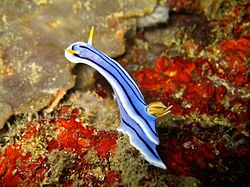| Chromodoris | |
|---|---|
 | |
| Chromodoris lochi | |
 | |
| Chromodoris joshi in the Komodo National Park | |
| Scientific classification | |
| Kingdom: | Animalia |
| Phylum: | Mollusca |
| Class: | Gastropoda |
| Order: | Nudibranchia |
| Family: | Chromodorididae |
| Genus: | Chromodoris Alder & Hancock, 1855 [1] |
| Type species | |
| Doris magnifica Quoy & Gaimard, 1832 | |
| Species | |
See text | |
| Synonyms | |
| |
Chromodoris is a genus of very colourful sea slugs or dorid nudibranchs, marine gastropod molluscs, and the type genus of the family Chromodorididae. Within the genus Chromodoris, there are currently 101 classified species. Species within Chromodoris are commonly found in tropical and subtropical waters, living as members of reef communities and preying primarily on sponges. [2] A molecular phylogeny of the family Chromodorididae resulted in this genus being restricted to a smaller number of species than formerly, most of which have longitudinal black lines on the mantle. Many former members of Chromodoris were transferred to Goniobranchus














